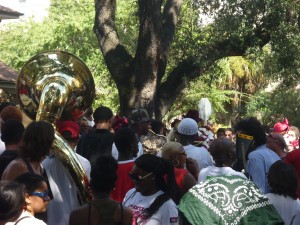‘Talkin’ revolution’ – that’s a ‘nice’, ‘safe’ activity, says Jerry Ward, who had been invited to speak of his early involvement as a student in the Free Southern Theater, founded in 1963 in Mississippi as part of the civil rights movement, and commemorated here in New Orleans, where it eventually moved, 50 years later. ‘It’s easy to talk.’ I had been thinking something similar before arriving at Friday’s panels, only because the organizers of the wonderful 3-day event to commemorate and celebrate this radical theatre’s history had chosen a provocative title.
Academics in particular do a lot of talking about revolution and theorizing radical politics without necessarily demonstrating a great deal of commitment to the everyday messiness of actual political engagement. This particular instance of ‘talking revolution’ on a university campus (Tulane) was taking place amidst an array of other activities including dance performances, a civil rights bus tour and a variant of the Free Southern Theater’s own formalistic invention: the story-circle. I was a bit sorry that the only part I was able to attend consisted of the ‘academic’ sessions. Little did I know.
The day began with the singing of freedom songs, a theme that continued into the first roundtable discussion that was concluded by a song sung by FST founder John O’Neal. This discussion was presented as an opportunity to listen and learn from our ‘elders’, a sign of respect I hear a lot over here that is markedly absent from discourse at home. The ‘elders’ certainly took advantage of their position in that what began as friendly reminiscences evolved into a very frank and sometimes difficult intra- and intergenerational dialogue. Moving to New Orleans, FST founder Doris Derby stated – to her New Orleanian descendants and hosts – was a mistake. In fact, it was a major reason for her leaving the FST. ‘Me and Doris have not been entirely honest here’, says O’Neal, conspiratorially, with regards to this move that he (and the late Gilbert Moses, the third FST founder) supported and Derby did not: ‘as a woman we expected her not to have an opinion’ (it was not entirely clear that Derby was in on this conspiracy: sadly I wasn’t able to stay for the day’s final session dedicated to the experiences of FST women). And then later, did I hear Jerry Ward say: ‘[contemporary?] African American theatre is pathetic’? A slightly tricky pronouncement given that his audience was in large part made of up people committed to making those entities that have been inspired by FST work.
‘Theatre is dead’, claimed Kalamu ya Salaam, an FST alum whose influence on the black arts scene in New Orleans and beyond cannot be over-estimated. It seemed that in the second panel as well, polite dialogue had been traded in for some very honest and uncensored conversations. Conversations that seemed to live up to Salaam’s challenge that art always be engaged, despite the costs.
‘When you speak the truth you don’t get the support’, Carlton Turner, director of art collective Alternate ROOTS, agreed; though his insistence on theatre’s continuing power to engage community and re-engage democracy was un-fazed by Salaam’s apocalyptic pronouncement. If you continue to push the hard questions you end up on Watch List and having your conversations taped, Turner said. You keep on being deprived of money but you continue in spite of that.
A difficult dialogue to hear for academics in the arts and humanities who face shrinking job opportunities and increasing dependence on external grantmakers. In the UK, the government’s ‘impact’ agenda, which is calling on academics to demonstrate the relevance of their research beyond the ivory tower, should be about just the kind of social engagement these artists are calling for, constantly posing the question: ‘what values are you bringing into this space?’ (Turner). In reality, ‘impact’ insults both academic researchers and the wider publics that they ought to engage. It downgrades the function of research in the arts, both as an important endeavour in its own right – as a contribution to knowledge and cultural memory – and as a crucial part of teaching students, which is the principal task of arts and humanities departments. ‘Impact’ also proposes a patronizing, top-down approach to public engagement, a one-way exchange whereby the academic delivers knowledge to the people, with little consideration for community needs or reciprocity. Worst of all, ‘impact’ is about the marketization of knowledge: how can your research contribute to the UK economy?
A very different model of academic engagement had an important presence on this second panel: Jan Cohen-Cruz is an artist, scholar and former director of Imagining America, which is a consortium of US universities that have come together to work to realize the goal that higher education contribute to the greater public good, by supporting engaged scholarship and creative practice. Read their recently launched journal, Public, here. IA has been involved in all kinds of community engagement projects, including HOME, New Orleans, a project in which Cohen-Cruz and others explored the ways in which public art might play a role in rebuilding communities after Katrina.
Inevitably, conversations here turn to Katrina. An education justice activist commented that it was important to table education reform – meaning the firing of thousands of largely African American veteran teachers after Katrina, who were then replaced with largely white twenty-somethings working for Teach for America, an organization that is meant to offer the brightest teachers to the most disadvantaged neighbourhoods, but which actually subjects children to inexperienced, non-unionized staff who have received just five-six weeks training. After Katrina New Orleans became the centre of the so-called ‘charter school movement’, which has subjected often traumatized students to teachers unaware of community needs, who have often had to carry through a ‘no excuses’ agenda (including draconian disciplinary measures like silent lunches and ‘benches of shame’) that traumatize students and their young teachers alike. This conversation led Catherine Michna to pose perhaps the most challenging question of the day: ‘African American communities are being pushed out of neighbourhoods, colonized, killed and imprisoned: what can theatre do?’
Hurricane Katrina, scholar James Smethurst pointed out, enacted a ‘dramatic disruption of cultural memory’. A disruption that many on the left have wanted to name ethnic cleansing. But, as Smethurst commented, a version of the Katrina disaster is playing out across the United States, as neoliberal gentrification trends continue to displace communities and exacerbate divides between rich and poor. It might also be added that these are global trends: the New York Times has recently reported that London’s soaring house prices (in sharp contrast to the dire economic situation elsewhere in the country) makes the city a ‘bubble’, a tax haven for the rich that’s been bought at the expense of long-time residents whose children can no longer afford to live there. How does one get hold of cultural memory under such circumstances, asks Smethurst?
‘Where are the children here?’ asked Ward, in another provocative contribution to conference proceedings. The presence of children, all agreed, was essential to doing the work of building an archive (of the FST – which O’Neal repeatedly stated must be seen in the light of its failures as well as its successes) to be passed on. Where were the 15 and 16 year olds? Ward insisted. This led to a fascinatingly reflexive conversation whereby the participants considered the construction of the conference programme, which though well-intentioned, they reasoned, had allowed this crucial omission.
Their hosts, Junebug Productions (an heir to the FST), under the directorship of Stephanie McKee, sat good humouredly by, presumably proud in the knowledge that they had staged an event that had allowed people to speak their truths to power and go way off-script, to the point of questioning the form of the proceedings themselves. It is tempting to compare the improvised nature of the event to a jazz performance; certainly I felt that in coming to the ‘academic’ panels, I had still got a little bit of theatre. Impromptu audience contributions broke down the boundary between performers and spectators in just the way that the FST envisaged. There were no signs of impending revolution here, but the talk challenged everybody in the room, the university as an institution, and the conference as a platform for polite, contained dialogue. And it opened my eyes to what truly ‘talkin’ revolution’ might look like.

